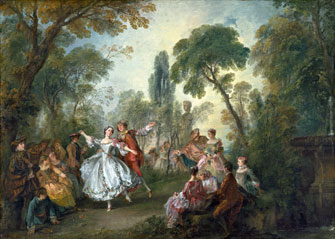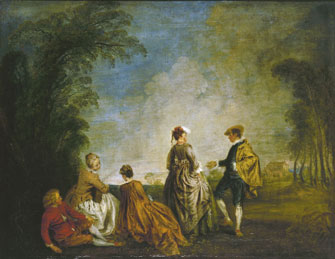‘The Science of
Sensual Pleasure’

“Fête Galante avec la Camargo Dansant avec un Partenaire” (1727-28), by Nicolas Lancret © Courtesy National Gallery of Art, Washington
In the age of Casanova, naughtiness was definitely seen to be nice. And nowhere was it seen to be nicer than in the French paintings known as “fêtes galantes,” in which amorous encounters bring piquant life to idyllic forest glades, the subject of the current exhibition at Paris’s Musée Jacquemart-André.
The genre celebrated a refined libertinism framed within the formal etiquette of a courtly society – seduction as performance art. Emerging early in the 18th century and flourishing in France until the Revolution swept away the fantasies and frivolities of the ancien régime in 1789, it expressed in painting what the 17th-century soldier, essayist and hedonist Charles de Saint-Évremond expressed in words: “You must forget the time when it was enough to be severe to be virtuous. Politeness, gallantry and the science of sensual pleasure are what are considered to matter now.”
The show, which brings together 60 paintings from collections around the world, pays homage to three great masters who between them spanned the age of gallantry in decorative painting: Watteau, Boucher and Fragonard.
Jean-Antoine Watteau (1684-1721), the first to develop the theme, drew on 16th- and 17th-century Venetian and Flemish country scenes for inspiration, but in place of neoclassical landscapes peopled with heroes and goddesses, or the boisterous, bucolic peasant feasts of the Flemish tradition, he created intimate, pastoral settings for games of seduction.
This delightful genre, full of light and color, was suggestive but scrupulously avoided vulgarity. It was hugely successful with the newly rich bourgeoisie who didn’t want to be

“La Proposition Embarrassante” (c. 1715-20) by Antoine Watteau Photograph © The State Hermitage Museum/Vladimir Terebenin
lectured on history and morality. What they wanted was lighthearted entertainment to adorn the paneling of their salons and boudoirs.
A good early example is “L’Amour Paisible,” painted by Watteau in 1718. It depicts two couples and a threesome engaged in various forms of banter and flirtation. In the foreground, a dog slumbers; in the background, a shepherd sits with his flock. The group, lit by a late summer sun, is framed against the background of an Italianate Renaissance landscape.
Village fetes, country marriages, theatrical performances and masques were typical subjects. Where Watteau painted scenes drawn from the imagination, his immediate followers introduced a sort of virtual reality based on elements of contemporary social life, exemplified in the “Dejeuner de Chasse,” a picnic scene painted in 1723 by François Lemoyne (1688-1737). It depicts a group of fashionably dressed ladies and gentlemen lunching by a forest bridle path, accompanied by their horses and hounds, with the day’s game catch spread on the ground beside them – the ideal country life, complete with guns.
Around the middle of the 18th century, François Boucher (1703-70) returned the form to more escapist fancies. Rather than elegantly fashionable gentry, he painted voluptuously curvaceous, extravagantly costumed shepherdesses, often with classic statuary in the background. “Les Charmes de la Vie Champêtre,” painted around 1740, typifies his style. Marie Antoinette comes to mind, playing out her milkmaid games in her model village at Versailles.
And then, in a burst of painterly enlightenment, comes Jean-Honoré Fragonard (1732-1806), hijacking a now tired artistic cliché for his own purposes. Sharply observed, impressionistic in light and brushwork a century before the Impressionists, rich in symbolism and complexity, “La Fête à Saint-Cloud,” painted around 1780, closes out the show with revolutionary bravura – just as the

“La Fête à Saint-Cloud” (c. 1775-80), by Jean-Honoré Fragonard © RMN-Grand Palais/Gérard Blot
Revolution closed out the age of gallantry a decade later. In the setting of a romantically landscaped park, against the backdrop of a giant fountain spouting water into the sky, spectators cluster around a scattering of entertainments and attractions – puppeteers, hawkers’ booths, mountebank performers. In the foreground, an ornamental tree in a wooden tub lies knocked over on its side: allegories and illusions in the fairground of life.
Owned by the Bank of France and rarely on public show, this painting alone would make the exhibition a must-see, at least for admirers of a very French painterly tradition.
Musée Jacquemart-Andre: 158, boulevard Haussmann, 75008 Paris. Métro: Miromesnil. Tel.: 01 45 62 11 59. Open daily, 10am-6pm, until 8:30pm on Monday and Saturday. Admission: €11. Through July 21, 2014. www.musee-jacquemart-andre.com
Reader reaction: Click here to respond to this article (your response may be published on this page and is subject to editing).
Please support Paris Update by ordering books from Paris Update’s Amazon store at no extra cost. Click on your preferred Amazon location: U.K., France, U.S.
More reviews of Paris art shows.
© 2014 Paris Update
Favorite